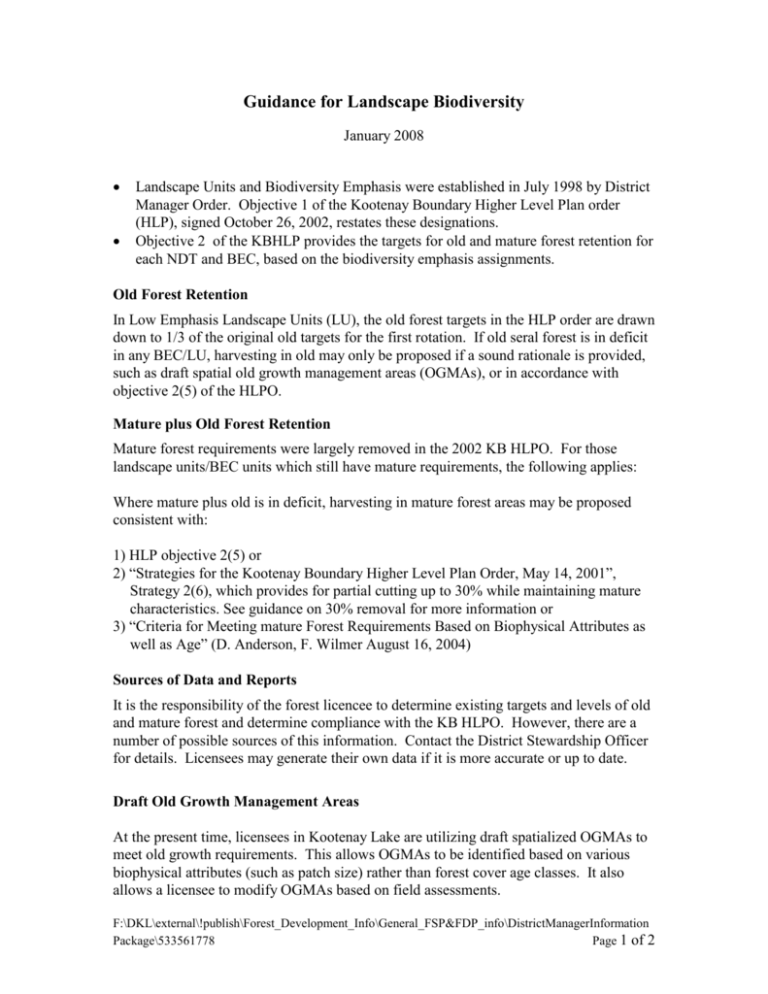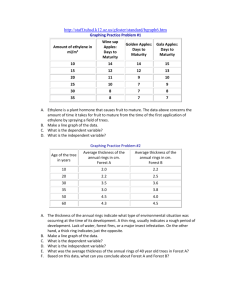DKL 2008 Landscape Biodiversity
advertisement

Guidance for Landscape Biodiversity January 2008 Landscape Units and Biodiversity Emphasis were established in July 1998 by District Manager Order. Objective 1 of the Kootenay Boundary Higher Level Plan order (HLP), signed October 26, 2002, restates these designations. Objective 2 of the KBHLP provides the targets for old and mature forest retention for each NDT and BEC, based on the biodiversity emphasis assignments. Old Forest Retention In Low Emphasis Landscape Units (LU), the old forest targets in the HLP order are drawn down to 1/3 of the original old targets for the first rotation. If old seral forest is in deficit in any BEC/LU, harvesting in old may only be proposed if a sound rationale is provided, such as draft spatial old growth management areas (OGMAs), or in accordance with objective 2(5) of the HLPO. Mature plus Old Forest Retention Mature forest requirements were largely removed in the 2002 KB HLPO. For those landscape units/BEC units which still have mature requirements, the following applies: Where mature plus old is in deficit, harvesting in mature forest areas may be proposed consistent with: 1) HLP objective 2(5) or 2) “Strategies for the Kootenay Boundary Higher Level Plan Order, May 14, 2001”, Strategy 2(6), which provides for partial cutting up to 30% while maintaining mature characteristics. See guidance on 30% removal for more information or 3) “Criteria for Meeting mature Forest Requirements Based on Biophysical Attributes as well as Age” (D. Anderson, F. Wilmer August 16, 2004) Sources of Data and Reports It is the responsibility of the forest licencee to determine existing targets and levels of old and mature forest and determine compliance with the KB HLPO. However, there are a number of possible sources of this information. Contact the District Stewardship Officer for details. Licensees may generate their own data if it is more accurate or up to date. Draft Old Growth Management Areas At the present time, licensees in Kootenay Lake are utilizing draft spatialized OGMAs to meet old growth requirements. This allows OGMAs to be identified based on various biophysical attributes (such as patch size) rather than forest cover age classes. It also allows a licensee to modify OGMAs based on field assessments. F:\DKL\external\!publish\Forest_Development_Info\General_FSP&FDP_info\DistrictManagerInformation Package\533561778 Page 1 of 2 It is acceptable to construct roads through draft OGMAs, though alternatives should be pursued if feasible. Harvesting for purposes of salvage or forest health is also acceptable, but the post-harvest stand should be examined to determine whether old growth attributes still remain, or whether additional OGMA area should be identified elsewhere. Agency approval is not required for these changes. Under FRPA, the responsibility lies with the professional who makes the alteration. A written rationale and map should be put on file for all such changes. Changes should also be forwarded to the Kootenay Lake Stewardship Officer, for roll-up into the single District coverage. This used to be the responsibility of the Integrated Land Management Bureau, but they no longer provide this service. Small remnant old growth patches outside of draft OGMAs can be harvested, but it is recommended that these be considered for their potential as wildlife tree patches where feasible. Early Seral Forests See “Early Seral Patch Analysis” for information on introduction of a range of harvest patch sizes into a landscape unit. “Connectivity” Objective 5 of the KB HLPO references regional connectivity maps, and states that old and mature forest targets should be preferentially located there. However, this should not compromise other, more critical ecological elements such as early seral patch sizes, specific wildlife requirements, and attribute-based OGMAs. Practically speaking, the connectivity objective is unclear and confusing and could have negative implications for landscape level biodiversity if interpreted in certain ways. Efforts have been made to have this objective removed from the KB HLPO, but so far without success. At the present time, the connectivity corridors are just one consideration among many when spatially locating old growth or mature recruitment areas. Shared Landscape Units Communication between licensees in shared landscape units is essential, particularly with regard to any changes which are made to draft OGMAs, and in conducting early seral patch analyses. F:\DKL\external\!publish\Forest_Development_Info\General_FSP&FDP_info\DistrictManagerInformation Package\533561778 Page 2 of 2






